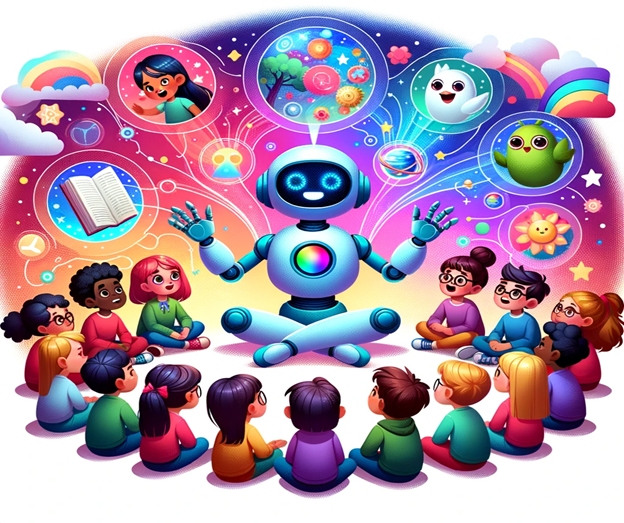Do you recall how story time would excite you so much as a kid? There was just something magical about sitting in a circle with peers, eagerly listening to a story read aloud by your teacher, or snuggling up with mum during bedtime to hear your favorite story.
There’s a reason stories have such a powerful pull: they’re one of humanity’s oldest and most impactful ways of sharing knowledge and communication.
Today, technology has redefined this age-old ritual, adding layers of depth and interactivity that supercharge the storytelling experience. The digital age has created tools and platforms to enhance and elevate these narratives, making them more immersive and influential.
Kids have a fertile imagination and naturally gravitate towards stories as a learning tool. By combining technology with storytelling, we can create experiences that entertain and deeply resonate, fostering emotional learning and development in children like never before.
What makes stories so powerful?
Neuroscientific research shows that stories light up our brains, releasing chemicals such as oxytocin and dopamine that enhance focus and deepen emotional bonds. This is why we’re more likely to remember facts when they’re woven into a story rather than listed in bullet points. Various studies and research support the impact of storytelling on learning and development. Here are some insights:
- Cognitive benefits: A study from the Early Childhood Research Quarterly found storytelling to be pivotal in enhancing vocabulary and language skills among preschoolers.
- Emotional development: Storytelling has been shown to enhance emotional intelligence. A study from Pace University showed that storytelling could effectively teach preschool children emotional intelligence skills.
- Creativity enhancement: The Journal of Creative Behavior observed that children who indulge in storytelling exhibit heightened creativity and problem-solving abilities.
- Social and cultural awareness: The National Literacy Trust highlights storytelling as a means for children to understand varying cultures, enriching their global perspective.
- Positive impact on academics: The Educational Journal of Living Theories indicates that storytelling enhances memory retention and understanding, leading to better academic performance.
How to leverage technology in storytelling
Here’s a breakdown of how technology can be woven into storytelling, optimizing emotional learning:
Interactive eBooks
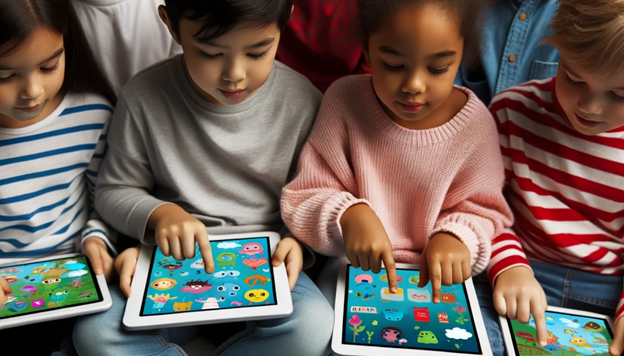
Modern eBooks are now bustling with embedded videos, animations, and interactive elements that breathe life into stories, making them more engaging and immersive.
For children, these additions are not just entertaining but also educational. With animations, the movement and expressions of characters can be vividly portrayed, offering a richer understanding of the narrative. Videos can provide context, background, or even expert commentary, deepening a child’s comprehension of the material.
The interactive elements might be the most innovative aspect. These features have the power to choose what happens to characters or look into different endings.
A story about handling emotions might let readers dictate a character’s choices, watching emotional consequences unfold. This mirrors real-life decision-making, honing empathy and emotional understanding.
Let’s use an eBook about marine life as an example. Through Augmented Reality (AR), a child might see a dolphin leap across their room or a coral reef expand on their wall. Such experiences evoke wonder and curiosity, tying the emotional to the educational.
Virtual Reality (VR) and Augmented Reality (AR)
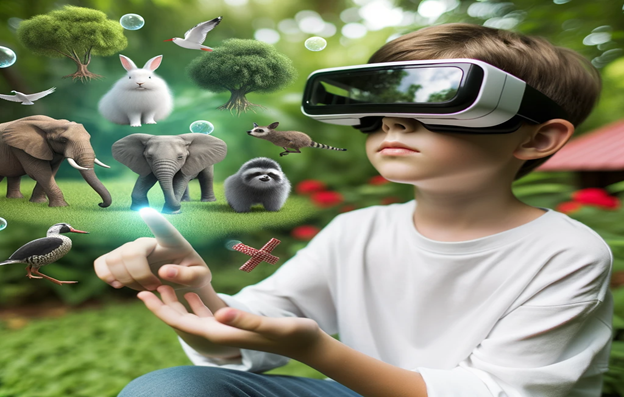
VR and AR are all the rage today, and for good reason.
Imagine a child donning a VR headset and suddenly finding themselves in the heart of a dense forest, where they can join the protagonist on a quest. Every decision made, every challenge faced, and every emotion felt by the character is experienced in real time by the child. They don’t just read or hear about the character’s fear or joy; they feel it.
Similarly, with AR, kids can interact with holographic characters right in their living rooms or see story elements superimposed onto their real-world surroundings. It’s like having the story come to life around them. For instance, while reading about marine life, an AR application might project a dancing dolphin or a colorful coral reef onto their bedroom wall, making the reading experience informative and interactive.
Such deep immersion has profound implications for emotional learning. Studies suggest that experiential learning – where individuals learn by being directly involved in an experience – can be one of the most effective ways to understand and retain information.
When children are “living” the story, they are more likely to relate to the characters and understand their emotions. This kind of empathy-building is crucial, as it enhances the reading experience and helps children develop social and emotional intelligence.
Storytelling apps

Apps that empower children to craft their own narratives are invaluable tools for emotional development and expression. By allowing kids to become the creators and narrators of their own stories, these apps tap into the vast potential of their imaginations, helping them process their feelings, build empathy, and enhance their problem-solving skills. Here’s how:
Self-expression: Storytelling apps provide children with a safe platform to express their feelings and emotions, which might sometimes be difficult for them to communicate verbally.
Empathy building: By placing themselves in the shoes of their characters, children can better understand and feel the emotions of others.
Problem-solving and critical thinking: Constructing a narrative requires a beginning, middle, and end and often involves conflict and resolution.
Understanding complex emotions: Crafting stories can help children grapple with complex emotions such as jealousy, grief, or anxiety.
Boosting creativity: Beyond emotional development, storytelling apps fuel creativity. Children can experiment with different plots, characters, and settings, allowing their imaginations to run wild.
Learning outcomes: Incorporating elements from their daily lives or subjects they learn at school into their stories can reinforce their academic knowledge.
Video conferencing

In an era where video calls and virtual interactions are becoming the norm, the ability to recognize and interpret emotions, even via screens, becomes increasingly important.
Using video conferencing tools like Workee in the classroom can provide students with an invaluable opportunity to explore the vast emotional and cultural tapestry worldwide. Here’s how:
Bridging cultural gaps: Video conferencing tools in the classroom can foster regular interactions with students from diverse backgrounds and help dispel stereotypes and misconceptions. This fosters a sense of unity, respect, and appreciation for different cultures, traditions, and ways of life.
Collaborative learning: Think of virtual exchange programs. Imagine American students connecting with teachers and peers in Tokyo, sharing urban legends. Video conferencing enables cross-country collaborations, fostering teamwork, communication, and compromise as students navigate the emotional intricacies of group work.
Emotional recognition games
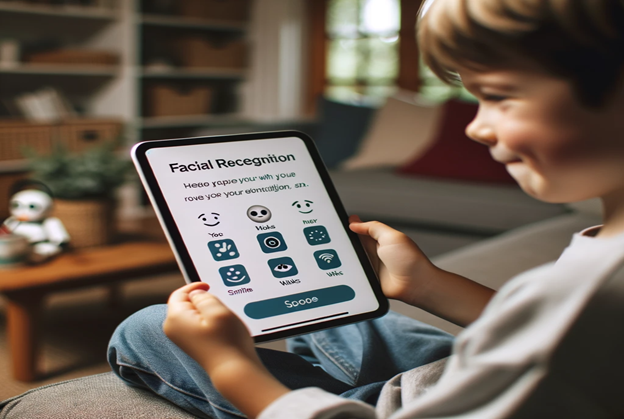
Games or apps that use facial recognition can help children recognize and name their feelings, an essential step in emotional intelligence.
These games provide real-time feedback. If a child misidentifies an emotion, the game can correct it instantly, allowing for immediate learning. It also fosters personalized learning. For example, a child struggling with distinguishing between certain emotions can receive more exercises focused on that area, ensuring individualized progress.
Gamified learning

A revolutionary way to help kids develop their emotions is through gamified storytelling. Kids can choose what happens to characters by interacting with them, strengthening their emotional connection, and building empathy. This method creates a secure space for exploring complicated feelings, and the quick feedback helps people think about what they’re doing and how they can improve. Story-driven games give you a sense of what’s happening, and multiplayer modes help you work together and get along with others.
With the added benefits of tracking progress, cultural exposure, and personalized learning paths, gamified learning effectively combines games’ fun and interactive aspects with the deep and rich content of stories. It gives kids a deeper understanding of emotions and prepares them for emotional situations that may arise in real life.
AI lesson Plan generators
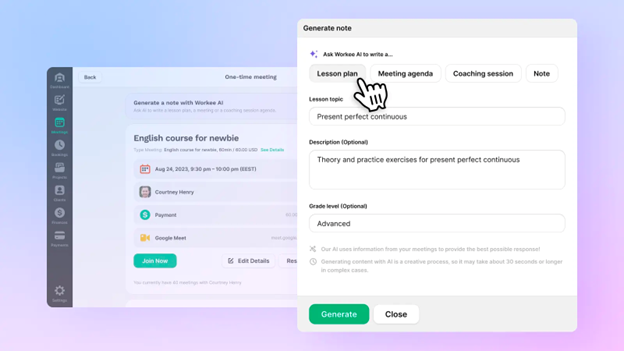
One of educators’ biggest challenges is customizing lessons to suit children’s diverse emotional and developmental needs. This is where AI lesson plan generators like Workee AI shine. By using tools like Workee AI, educators can easily craft lesson plans tailored for emotional learning and development.
Workee AI is an AI-powered assistant that can create efficient lesson plans tailored to any topic and grade level, saving time and enhancing the quality of your lessons. By leveraging Workee AIl, educators can:
Customize lessons according to topic: Whether it’s a lesson on the emotional turmoil of losing a pet or the joys of making a new friend, just specify the topic, and Workee AI will generate a precise lesson plan for it.
Tailor lessons according to the audience: By identifying the student’s grade, lessons can be tailored to address specific emotional needs according to grade level.
Structured emotional learning: Workee AI provides a well-organized plan, ensuring the lessons are delivered progressively and effectively.
Efficient planning and sharing: With time recommendations, educators can ensure the lesson doesn’t drag or feel rushed. Plus, the sharing option allows for collaborative input, ensuring that students and parents know the lesson plans ahead of time and are on the same page.
Key Takeaway
Incorporating technology into storytelling doesn’t mean replacing traditional methods but enhancing them.
By using tools like Interactive eBooks, Virtual Reality (VR) and Augmented Reality (AR), Storytelling apps, and Workee AI to streamline lesson planning, you’re not just entertaining your kids; you’re equipping them with vital tools for enhancing memory, emotional intelligence, contextual understanding, and creativity.
So the next time you have something important to teach or convey, don’t just tell it— use technology to storytell it!

